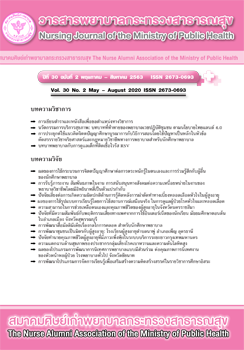Development of Multimedia on Mechanisms of Labour for Nursing Students
Main Article Content
Abstract
Using multimedia for teaching and learning can help students to become independent learners. The objective of this study was to develop multimedia on mechanisms of labors for nursing students. This research study was conducted with 119 3rd year nursing students. The research instruments were comprised of 1) the Educational multimedia on labor processes which was evaluated by 3 content experts and 3 educational technology experts, 2) the Knowledge test on labor processes with 20 items which had an index of item objective congruence (IOC) of 1, and 3) the Student’s satisfaction on labor process multimedia with an IOC of .93. The development of educational multimedia consisted of 3 steps: Step 1 was a pilot test and improvement of educational multimedia using stratified sampling of 13 students who had learning outcome at high, moderate and low levels. The first trial of analysis was conducted with 3 students prior to implementation with another group of 10 students. Step 2 was the reliability testing of Knowledge on labor processes on 30 nursing students with a Cronbach alpha’s coefficient of .7 and the Student’s satisfaction questionnaire with a Cronbach alpha’s coefficient of .93. Step 3 was an evaluation of the effectiveness of the educational multimedia using 76 nursing students. The results indicated that the effectiveness index: (E.I.) of the educational multimedia on labor processes was .67. Students’ knowledge on labor processes after learning through educational multimedia was significantly higher than that of the pretest (p<.001). The findings revealed that student’s satisfaction towards Educational multimedia on labor processes was at a high level with a mean score of 4.40 (SD=10.69). In conclusion, the results of this study show an effective educational innovation for nursing education which can be used for alternative way of teaching and learning in the 21st century.
Article Details
บทความและรายงานวิจัยในวารสารพยาบาลกระทรวงสาธารณสุข เป็นความคิดเห็นของ ผู้เขียน มิใช่ของคณะผู้จัดทำ และมิใช่ความรับผิดชอบของสมาคมศิษย์เก่าพยาบาลกระทรวงสาธารณสุข ซึ่งสามารถนำไปอ้างอิงได้
References
2. Yodnoi W. Multimedia for learning [internet] 2012. [cited 28 August 2018] Available from https://wanussanun.wordpress.com
3. Songkram N. Design and development for learning. Bangkok: Chulalongkorn University Publising 2010. (In Thai).
4. Buajama P. Development of internet video to support the public volunteer for bachelor degree student in major of education technology and communications at Raja Mangala University of Tecnology Thanyaburi, Pathum Thani province [Master thesis]. Pathum Thani: Raja Mangala University 2012. (In Thai).
5. Chunggis J. The development of instructional video on physical examination in health assessment course based on flipped classroom concept. Pathum Thani province [Master thesis]. Pathum Thani: Raja Mangala University 2016. (In Thai).
6. Bandura, A. Self-efficacy. In the Corsini Encyclopedia of Psychology. 4thed. Hoboken, New Jersey: John Wiley & Sons 2010;1534-6
7. Lamchang S, Kiatwattanacharoen S. Effects of self-learning by using multimedia on knowlede and self-condence in nursing practice for children with acute respiratory tact infection among nursing students. Nursing Journal 2014;41(2):107-16. (In Thai)
8. Yodnoi W. Teacher role of apply ICT in classroom [internet] 2012 [cited 28 August 2018]. Aviable from https://wanussanun.wordpress.com. (in Thai)
9. Lee WW, Owens DL. Multimedia-based instructional design: computer-based training, web-based training, distance broadcast training, performance-based solutions. San Francisco: Pfeiffer. 2004
10. Pilot DF, Beck TB. Nursing research: principles and methods. 7thed. Philadelphia: Lippincott Williams & Wilkins. 2004
11. Bandura A. Social cognitive theory. In PAM. van Lange, AW Kruglanski, ET Higgins (Eds.). Handbook of social psychological theories. London:Sage. 2011.
12. Tuntavanitch P, Jindasi P. The real meaning of IOC. Journal of Educational Measurement, Mahasarakham University 2018;24(2):3-12. (In Thai)
13. Sinjindawong S, Item analysis method. Journal of Knowled Bank at Sripatum University 2018;21-33. (in Thai)
14. Srisa-ard B, Basic research. 9th ed. Bangkok: Suviriyasad. 2010;(In Thai)
15. Sriarporn ., Suntornlimsiri N, Phakphumi P, Rangsakun N, Kisakul P, Puangsombat A. Development of a multimedia electronic book “role of nurse in postpartum family planning”. Nursing Journal 2020; 47(1):25-34 (In Thai)
16. Promton M, Wangsrikhun S, Sukonthasarn A. Effect of using computer assisted instruction for emergency department triage on nurses’ triage accuracy. Nursing Journal 2019;46(1):65-74 (in Thai)
17. Pansuwan K, Sangjak N. developing of computer assisted instruction on perineorrhaphy for nursing students. Journal of Nursing and Health Sciences 2014;8(3):38-47(In Thai).
18. Baka S,The construct mathematics programmed instruction on elementary data analysis for Mathayomsuksa six students. [Master thesis] Chonburi province: Bhurapha University 2015. (In Thai).
19. Moonprasarn O. The construction of a Programmed instruction package in mathematics on real numbers for Matthayomsuksa Four Students. Chonburi province [Master thesis]. Chonburi: Burapha University 2012. (In Thai).
20. Sethabouppha H, Skulphan S, Inthong S. Development of the integrated e-learning course for undergraduate nursing students. Journal of Education Naresuan University, 2016;18(3):1-11 (In Thai)

